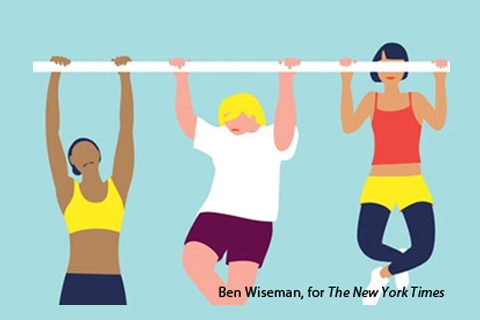Women, fitness, and pull-ups

When my daughter was in kindergarten, she was frustrated because she couldn't "do" the monkey bars. She made it a goal to be able to swing from the monkey bars going from one slide to another and, over several months and many blisters, she finally got there. In high school, she could do five pull-ups. Five. I credit those early monkey bar days with her amazing arm strength.
Like many other grown, fit women, I can't do a single pull-up. It was the one category of the 2012 AFM FITTEST that brought me up short. Sure, my burpees are fairly lacking and, well, my softball toss was laughable but I could DO them. I could at least bust out a couple of reps or complete the running and agility items with a time, but pull-ups quite literally left me hanging.
Why is it that men seem to be able to do pull-ups but so many women who are generally fit can't? It seems there are some physiological reasons. According to a recent article in The New York Times Magazine, three factors play into pull-up success: strength, low body fat, and shorter stature.
The muscles that power your pull-up are the biceps and latissimus dorsi, which is a large back muscle. Women tend to have about 60 to 80 percent of the muscle mass that men have. But just because a woman has less muscle mass doesn't mean she can't have similar gains in strength training. According to the National Strength and Conditioning Association, men and women have similar responses to resistance training. In other words–she can be taught!
When it comes to body fat, women naturally have more than men do, thanks to the estrogen that creates more developed breasts, wider hips, and more general fat. While being female also gives us a break on total body weight, we have (again) that lesser muscle mass to pull up that weight. It's not like we can just lose the extra body fat to become equal with guys; men can get as low as four percent in their body fat, while ten percent is very low body fat for women. Too low body fat for females can result in numerous health issues.
Short stature helps because of proportion. It seems that men who are taller or have longer arms, even though they may have more muscle mass, struggle with pull-ups. My trainer has said many times that a gymnast's body is a great one for pull-up success: short and very muscled with low body fat. Unfortunately, I've never been a gymnast.
But that's the thing–just because it isn't easy for me doesn't mean I can't do it. While the University of Dayton study reported in The New York Times Magazine did show that a control group of women had limited success with pull-ups after a three-month training period, what that simply says is that they needed more training. After all, four of the seventeen test subjects COULD do a pull-up while all of the women had increased their upper-body strength by 36 percent. And they'd gotten leaner, decreasing their body fat by two percent in the process.
Hamilton Nolan wrote, "I congratulate the University of Dayton researchers for proving that three sub-optimal workouts a week for three months is an insufficient level of training for most women to be able to do a pull-up.
If you have trained three months and you still can’t do a pull-up, what should you do? Train longer. Train harder. Train more. Train smarter. Train with greater specificity. Eventually, you will be able to do a pull-up."
While I welcome the explanation as to why pull-ups have (so far) been an elusive exercise for me, I'm not going to let the study's findings act as a crutch to give up. So I'm working to lower my body fat. I'm meeting with a strength trainer who's helping me develop the strength that I lack with a lot of challenging (and surprisingly fun) workouts. Fortunately, I'm pretty short–so I've got the stature thing going for me.
The goal is to be able to do one pull-up at the 2013 AFM FITTEST event. I've got time; I've been training; I can only do better.
What about the rest of you ladies?






